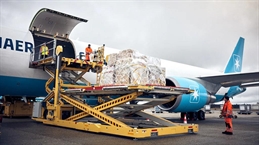
According to a new Baltic Air Freight Index (BAI) analysis, air freight prices remained largely unchanged in July, with most lanes showing flat rates for the period.
Writing for the Baltic Air Freight Index (BAI), Marc Zeck, senior research analyst at Stifel, said air freight rates on the Shanghai to Europe (BAI 81) trade lane dropped, however, by 10% month-on-month (MoM). Still, air freight rates remained 34% higher than a year ago.
In contrast, air freight rates on the Hong Kong to Europe (BAI 31) trade lane only slipped by 1% MoM and stood 23% above last year's prices at the end of the month.
Air freight rates for the Shanghai to North America (BAI 82) trade lane increased by 1% MoM and remained 31% higher than a year ago, while the Hong Kong to North America (BAI 32) trade lane saw air freight rates were virtually unchanged on a monthly basis and stood 20% above last year's prices at the end of the month.
"Air freight rates mostly moved sideways in July, further confirming our suspicion that we've reached a plateau for the summer months," Zeck said.
"Although the rate of change in air freight rates is tapering off, absolute freight rate levels remain elevated thanks to healthy growth in air cargo volumes," he added.
Citing IATA data for June, the analysis noted that global volumes increased by 14% YoY.
From a regional perspective, cargo volumes in Europe grew by 16% year-on-year (YoY), just slightly behind volumes growth in the Asia Pacific that advanced by 17% YoY.
Volume growth in the Middle East stood at 14% YoY, while the North American region was a bit slower at 10% YoY.
Zeck noted that the strong increase in demand outstripped capacity growth in all regions as the latter came in at just 9% YoY globally.
"Still, most of the observed increase in cargo volumes remains concentrated in e-commerce, according to our conversations with freight forwarders and carriers," he added.
Meanwhile, the senior research analyst at Stifel, said with respect to capacity, Airbus surprised the market at the end of June when it announced that it would cut back the plane delivery target for 2024 due to ongoing bottlenecks in the supply chains.
According to Airbus, the nature of supply chain bottlenecks has changed. A limited number of Tier-1 suppliers, mainly on the engine side, are responsible for current production delays, while previous production bottlenecks were caused by a high number of Tier-2 or even Tier-3 suppliers.
"Unfortunately, for Airbus, engine deliveries occur relatively late in the production process, which means there is considerably less time to react to engine shortages," Zeck said.
He noted that the same is also true for seats and cabin interiors that also experience production issues.
"Consequently, with Boeing production still curtailed, Airbus production might face an even higher level of volatility compared to past years, which will complicate fleet planning for airlines and, by extension, might negatively affect expected air freight capacity," the Stifel senior research analyst added.



